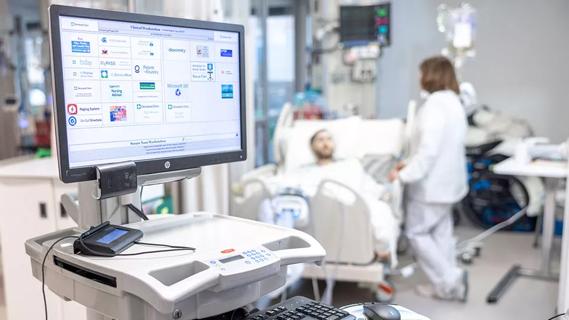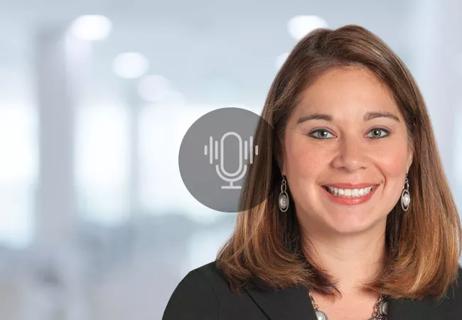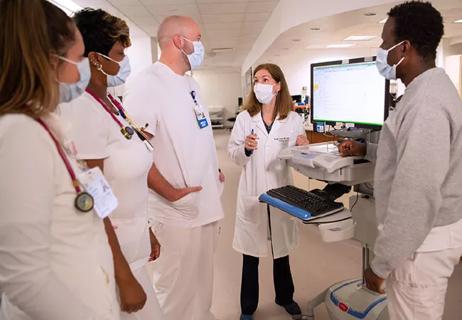A team approach to documentation optimization

Cleveland Clinic is optimizing its electronic medical record to save time, create efficiencies and enhance patient care.
Cleveland Clinic is a non-profit academic medical center. Advertising on our site helps support our mission. We do not endorse non-Cleveland Clinic products or services. Policy
After months of work, staff from the Office of Nursing Informatics unveiled a revised admission assessment document in Cleveland Clinic’s electronic medical record (EMR) system in April 2014. The simplified document, which is used for all inpatient admissions from medical surgical units to ICUs, was a hit with nurses: It decreased required data entry elements by nearly 75 percent and reduced the average time spent completing the assessment from 49 minutes to 18 minutes.
The Zielony Institute strives for EMR documentation optimization. That’s a dense phrase for a simple concept: “It’s all about leveraging technology to give time back to nurses for patient care,” says Marianela Zytkowski, DNP, MS, NEABC, RN-BC, FHIMSS, Associate Chief Nursing Officer of Nursing Informatics at Cleveland Clinic. Staff in her office worked to standardize and streamline documentation.
When Cleveland Clinic adopted Epic, its EMR system, the healthcare system transitioned many of its paper documents to electronic ones. But nurses soon realized that documents could be enhanced. “People constantly try to create electronic documents that replicate paper documents, and it’s just not going to work,” says Steve Mailer, BSN, RN, a manager in the Office of Nursing Informatics. “We need to let go of what we used to do on paper and capitalize on the strength of electronic medical records — for example, clinical decision support that is embedded in the EMR.”
Cleveland Clinic began the documentation optimization process in earnest a couple of years ago. “We look to decrease documentation when we can, although that’s not always possible,” says Marlene Oblak, RN, a manager in the Office of Nursing Informatics. “If we can’t decrease it, we strive to at least streamline it to make it a little easier.”
Last year, the Nursing Institute formed the Nursing Informatics Technology Council (NITC). One of the council’s responsibilities was to promote nursing satisfaction through standardization of documentation and optimization of the EMR. The NITC has approximately 50 members, including staff from Nursing Informatics, the Office of Quality and Practice, the Office of Nursing Education and Professional Development, and bedside nurses. This last group is vital to the council, as bedside nurses help determine what the ideal EMR should look like and validate changes or design drafts.
Mailer calls the revised admission assessment document “one of our biggest wins” because it affected caregivers enterprisewide. “We zeroed in on pieces of documentation that were unique to the admission process and removed extraneous data,” he says. In determining what data to weed out, the Nursing Informatics team considered the importance of data, based on regulatory agency requirements and hospital policies and procedures.
One section that was improved was documentation of medical history. Rather than including an extensive medical history list, documentation was pared down to a core list of pre-existing medical conditions that are important patient care factors. “Medical history was already being documented by other providers,” says Mailer. “Eliminating redundancies had an added benefit of improving the patient experience, as we decreased the number of repetitive questions patients were asked.”
Adding in clinical decision support is the key to many changes. Decision support tools include computerized alerts and reminders, condition-specific order sets, focused patient reports, and more. Last year, Cleveland Clinic began using a new delirium screening tool — a modified Brief Confusion Assessment Method (bCAM) — to better identify patients with delirium symptoms. In September, the healthcare system went live with a page in its nursing progress record that leads caregivers through the delirium screen.
The page begins with basic questions to determine whether patients’ status is at their pre-hospital baseline. Depending on patient responses, other follow-up questions appear. When patients test positive, nurses can click on a delirium intervention bundle, which is composed of a list of a dozen possible interventions to help patients. Interventions include minimizing unnecessary noise, frequently reorienting the patient, encouraging family member presence at the bedside, consulting with pharmacy on medications that may cause or alleviate delirium, and others. Finally, there is a link to a nursing protocol for care of patients with delirium.
“Dealing with delirium is a delicate balancing act from one patient to the next,” says clinical nurse specialist Catherine Skowronsky, MSN, RN, ACNS-BC, CMSRN. “To have everything right there at your fingertips at the bedside is so helpful.” Ultimately, that’s what all EMR documentation optimization is about: helping nurses and improving patient safety and care.

Customized bots improve speed, efficiency by streamlining daily clinical, clerical tasks

How healthcare technology is reshaping the clinical experience for nurses and patients alike

Analysis leads to faster, more user-friendly patient records

Technology is a valued member of the care team

Nursing informatics career brings together love of computer science and patient care

Pre-recorded audio messages reduce readmissions and more

Nurses welcome machines as newest member of care team

Agility is key to implementing new technologies